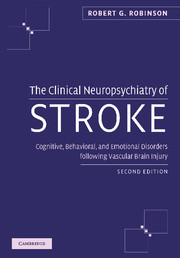 The Clinical Neuropsychiatry of Stroke
The Clinical Neuropsychiatry of Stroke Book contents
- Frontmatter
- Contents
- Preface
- Part I Introduction
- Part II Poststroke depression
- 5 Diagnosis of depression
- 6 Prevalence of depressive disorders
- 7 Phenomenology and specificity of depressive symptoms
- 8 Natural course of depression
- 9 Delayed-onset depression
- 10 Relationship to lesion location
- 11 Relationship of depression to cerebral dominance and structural asymmetries
- 12 Relationship of depression to bilateral hemisphere brain injury
- 13 Relationship of depression to physical impairment
- 14 Relationship to cognitive impairment and treatment
- 15 Relationship of aphasia to depression
- 16 Relationship of depression to social functioning
- 17 Relationship to premorbid risk factors
- 18 Mortality and treatment
- 19 Suicidal thoughts and plans
- 20 Biological markers
- 21 Mechanisms of poststroke depression
- 22 Treatment of poststroke depression
- 23 Prevention of poststroke depression
- Part III Poststroke mania
- Part IV Poststroke anxiety disorders
- Part V Other poststroke disorders
- Index
22 - Treatment of poststroke depression
from Part II - Poststroke depression
Published online by Cambridge University Press: 01 October 2009
- Frontmatter
- Contents
- Preface
- Part I Introduction
- Part II Poststroke depression
- 5 Diagnosis of depression
- 6 Prevalence of depressive disorders
- 7 Phenomenology and specificity of depressive symptoms
- 8 Natural course of depression
- 9 Delayed-onset depression
- 10 Relationship to lesion location
- 11 Relationship of depression to cerebral dominance and structural asymmetries
- 12 Relationship of depression to bilateral hemisphere brain injury
- 13 Relationship of depression to physical impairment
- 14 Relationship to cognitive impairment and treatment
- 15 Relationship of aphasia to depression
- 16 Relationship of depression to social functioning
- 17 Relationship to premorbid risk factors
- 18 Mortality and treatment
- 19 Suicidal thoughts and plans
- 20 Biological markers
- 21 Mechanisms of poststroke depression
- 22 Treatment of poststroke depression
- 23 Prevention of poststroke depression
- Part III Poststroke mania
- Part IV Poststroke anxiety disorders
- Part V Other poststroke disorders
- Index
Summary
Background
Although our use of treatment modalities in medicine has been driven by studies demonstrating efficacy of treatment, our choice among competing treatment is often influenced by our conceptualization of the cause of the disorder. Poststroke depression may be viewed from either a social–psychological perspective or a physiological–biological perspective. These two perspectives could lead to different and sometimes mutually exclusive treatment approaches. As evidenced by the number of studies of poststroke depression, both psychological and family interventions have been proposed or utilized, although the great majority of studies have examined pharmacological treatment. Clinicians, however, who view poststroke depression as an understandable consequence of unwanted physical dependency or inadequate social support may have little enthusiasm for pharmacological approaches. It is unlikely, however, that these conceptualizations are mutually exclusive and the most pragmatic approach is probably a combination of both pharmacological treatment and psychological assistance in addressing the patient's response to stroke related impairments.
In spite of increasing empirical support for the importance of pharmacological treatment in poststroke depression, there continue to be reports of patients who have not received adequate treatment or whose depression has not been treated. Patients whose depressions following stroke have not been recognized, in general, have failed to receive an assessment for poststroke depression.
- Type
- Chapter
- Information
- The Clinical Neuropsychiatry of StrokeCognitive, Behavioral and Emotional Disorders following Vascular Brain Injury, pp. 251 - 270Publisher: Cambridge University PressPrint publication year: 2006


